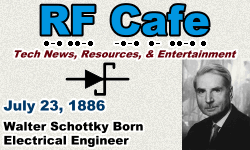|
 July 23 July 23
 1715: The first lighthouse in
America, Boston Lighthouse, was authorized for construction at
Little Brewster Island, MA. 1877: The first telephone and telegraph
line in Hawaii was completed.
1880: The first commercial hydroelectric power planet began operation in Grand Rapids,
MI. 1875: Isaac
Singer, inventor of the continuous-stitch sewing machine, died. 1886:
Walter
Schottky, of diode fame, was born. 1903:
Ford
Motor Company sold its first Model
A automobile. 1906: "America the Beautiful" was copyrighted by
Katharine
Lee Bates. 1916:
Sir William Ramsay, who discovered chemist who discovered the
inert gases - neon, krypton and xenon, and co-discovered argon, radon, calcium and
barium, died. 1930: Aviation pioneer
Glenn Curtiss died. 1962: The "Telstar" communications
satellite sent the first live TV broadcast to Europe. 1968: The PLO hijacked its
first Israeli El Al airplane. 1972:
ERTS 1 (Earth
Resources Technology Satellite), later called
LANDSAT, was
launched to start its multi-spectral scans of Earth. 1981:
Harvey Fletcher,
who first demonstrated stereophonic sound, died. 1995:
Inventure Place,
home of the National Inventors Hall of Fame in Akron, OH, opened to the public. 1715: The first lighthouse in
America, Boston Lighthouse, was authorized for construction at
Little Brewster Island, MA. 1877: The first telephone and telegraph
line in Hawaii was completed.
1880: The first commercial hydroelectric power planet began operation in Grand Rapids,
MI. 1875: Isaac
Singer, inventor of the continuous-stitch sewing machine, died. 1886:
Walter
Schottky, of diode fame, was born. 1903:
Ford
Motor Company sold its first Model
A automobile. 1906: "America the Beautiful" was copyrighted by
Katharine
Lee Bates. 1916:
Sir William Ramsay, who discovered chemist who discovered the
inert gases - neon, krypton and xenon, and co-discovered argon, radon, calcium and
barium, died. 1930: Aviation pioneer
Glenn Curtiss died. 1962: The "Telstar" communications
satellite sent the first live TV broadcast to Europe. 1968: The PLO hijacked its
first Israeli El Al airplane. 1972:
ERTS 1 (Earth
Resources Technology Satellite), later called
LANDSAT, was
launched to start its multi-spectral scans of Earth. 1981:
Harvey Fletcher,
who first demonstrated stereophonic sound, died. 1995:
Inventure Place,
home of the National Inventors Hall of Fame in Akron, OH, opened to the public.
| Jan
| Feb | Mar |
Apr | May |
Jun | Jul |
Aug | Sep |
Oct | Nov |
Dec |
Note: These
historical tidbits have been collected from various sources, mostly on the Internet.
As detailed in
this article, there
is a lot of wrong information that is repeated hundreds of times because most websites
do not validate with authoritative sources. On RF Cafe, events with
hyperlinks have been verified. Many years ago,
I began commemorating the birthdays of notable people and events with
special RF Cafe logos.
Where available, I like to use images from postage stamps from the country where
the person or event occurred. Images used in the logos are often from open source
websites like Wikipedia, and are specifically credited with a hyperlink back to
the source where possible.
Fair Use laws permit
small samples of copyrighted content.
|
 July 23
July 23